The collection of building codes (SNIP) on roofing will help us to determine the type of house coverage, which describes in detail the dependence of the choice of coverage on the existing roof slope. Failure to comply with the accepted standard leads to a violation of the integrity of the building.
Consider a concrete example of a small roof of an extension of a house, covered with metal tiles.
Selection roofing material for the extension, I clearly proceeded from design considerations, general appearance, since the roof of the house was from a similar coating.
The slope of the main roof is about 30 °.
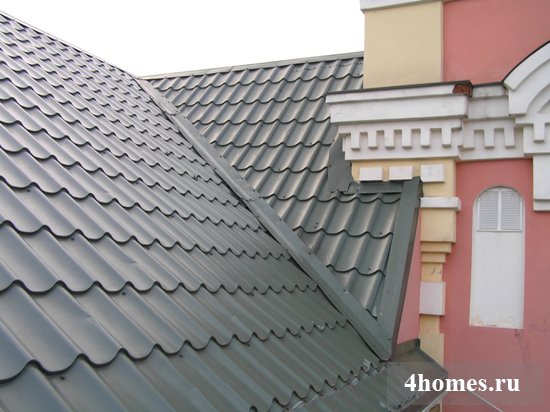
According to SNIP, the choice of metal tiles for it was logical and justified. On the extension, the roof slope was only 10 °, which immediately affected the performance of the coating. Technologically, the roof was arranged correctly, but due to the insufficient slope, it did not work correctly, that is, the water drainage was carried out incompletely. Precipitation accumulated along the abutments and flowed through the wave of metal tiles back into the roof, penetrating into the insulation, wooden structures and outer walls.
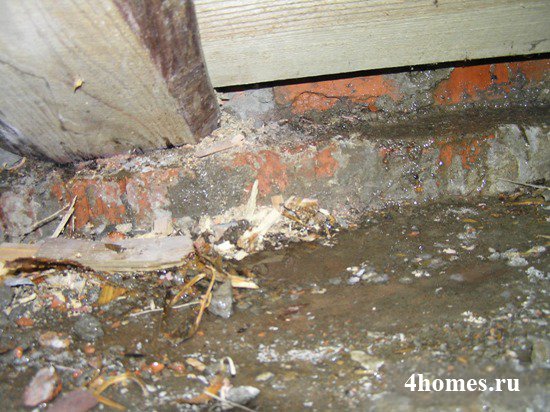
This led to decay rafter system, wetting and caking of the insulation, and hence a decrease in the thickness of the heat-insulating layer, destruction of the masonry and the plaster layer of the outer walls.
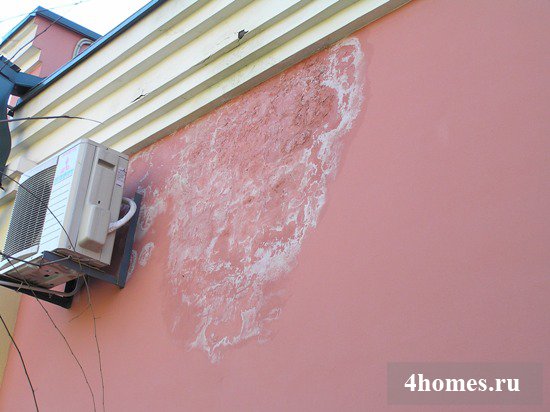
After examining the roof structures, it was decided to completely change the coating to another type that corresponds to the given slope, namely: soft roof made of modern weldable materials, the warranty period of which is at least 10 years. Construction term "Soft roofing" or "flexible roofing" is applied to roofing from roll materials. The permissible slope of such a coverage is from 0 ° and higher.
Also, such errors are corrected by increasing the slope, then the type of coverage can not be changed, but in our case, the roof of the extension was adjacent to the windows of the main building, which did not allow raising the slope.
![]()
Dismantling the old roofing
Before starting work on the installation of the soft roof, a temporary canopy of thick PVC fabric was arranged over the roof to be repaired to protect the ceiling during precipitation. It is easy to assemble and disassemble if necessary. 
We remove the entire cover from metal tiles, including abutment strips, parapets and overhangs. We leave the cover of the parapet made of thin painted metal in place to protect the wall from precipitation. We disassemble the lathing from the bar.
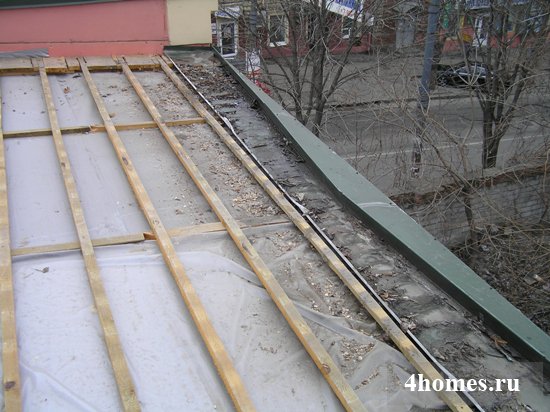
We remove the upper film waterproofing, vapor barrier and, which by its structure does not have sufficient rigidity for the subsequent construction of the base for surfacing with roofing material. During the disassembly of the cover, an error was found when laying the insulation. The insulation did not fit tightly at the rafter beams, which made it possible for cold air to penetrate the insulating layer.
Heat and vapor barrier before installing a soft roof

Our new insulation also belongs to the category of mineral. It is a hard basalt mats that will be laid in 4 layers of 50mm each. Basalt mats are an expensive, non-combustible and optimal insulation for the device of this roof. The density is 200 kg / 1 m3. This will allow you to lay a screed of two layers of DSP on it.
Basalt mats 500x1000 in size are tightly stacked to each other on the existing vapor barrier, forming an initial layer.
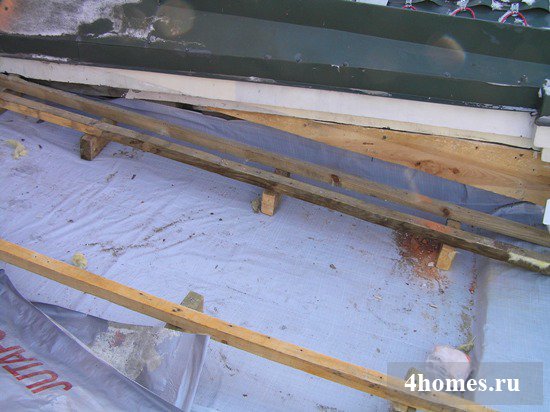
Then the mats of the next layer are laid in a staggered manner relative to the mats of the first layer, shifting the joints in order to prevent unnecessary heat loss and to create the uniformity of the insulating cushion.

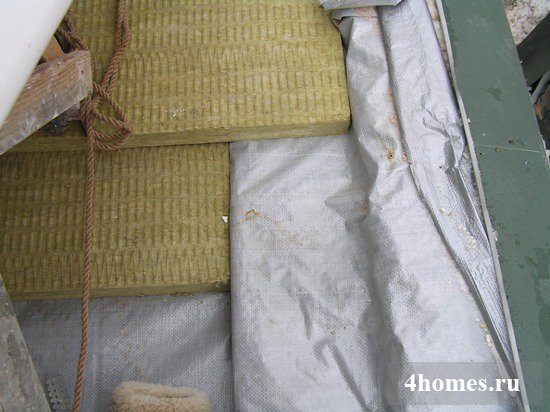

Then we fix both layers at the same time with a special dowel for insulation of the "umbrella" type measuring 10 x 85 (photo 13, 14).


Further, according to the same scheme, we form the third and fourth layers, not forgetting to lay the insulation with an overlap on the seams. During the installation of the insulation, it is necessary to carefully fill the nodes of the passage wooden structures purlins: the mats should fit snugly on all sides to the timber.
On top we lay a vapor barrier and sheets of DSP 3200x1250. The bottom layer of 16mm thick sheet is fixed to the existing purlins using universal galvanized screws 6 x 210. The top layer of 10mm thick sheet is mounted with an overlap, closing the joints, using screws 4.5 x 70. Along the abutments to the facade and parapet, we also attach DSP sheets up to 1000 mm high.
The inner corners of the abutments are smoothed with a rim made of cement-sand mortar M 150 (the ratio of cement and sand is 1: 3) for the subsequent tighter adhesion of the fused roofing material. If work is carried out in winter or during prolonged precipitation, when there is a need for quick implementation works, you can use special quick-hardening mixtures instead of a solution.

The horizontal screed and the vertical surface of the abutments are primed with a bituminous primer (primer) using a roller. Its consumption is approximately 0.4 kg per 1 m2.
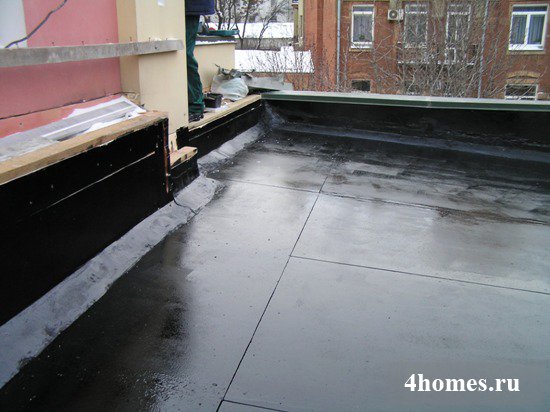
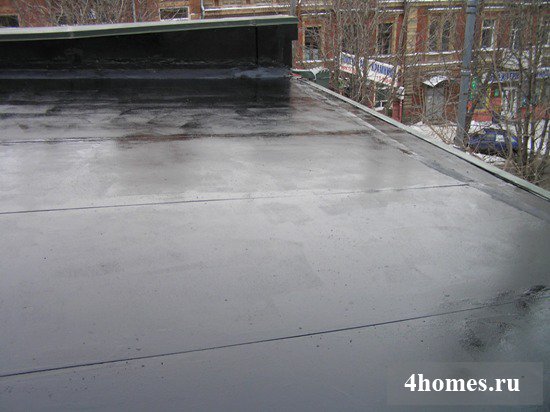
We mount the eaves strip with stainless screws 4.5 x 35 mm with a pitch of 500 mm along the edge of the roof.
Soft roof installation technology
The device of a soft roof involves two layers. First, we weld the bottom layer of the welded roofing material. It has a thicker base than the top layer and has a polymer film protective coating. There are several variations of the bottom layer: on polyester, fiberglass and fiberglass. We used a polyester-based material that has the best durability and flexibility. Before surfacing, we cut the material and lay it out, observing the direction in one direction. We take into account all the abutments in the cutting. Care must be taken to ensure that the overlay substrate is clean and dry.
Roofing material is fused with special equipment - burner, which is connected directly to the gas cylinder. The gas used is technical propane-butane. The lower part of the roofing material is sequentially heated with a burner until the protective coating begins to melt and is rolled onto the surface. The consumption of the lower layer is 1.15 m2 per 1 m2 of the roof.
After laying the first layer of the soft roof, we mount the ebb strip along the eaves with the help of stainless screws 4.5 x 35 mm, which will direct the water into the downpipe.
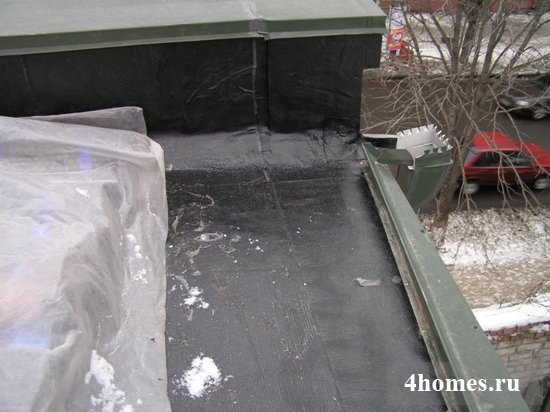
The rest of the protective elements of abutments, parapet coverings, window sills are attached after surfacing of two layers of roofing material. They cover the edges of the roofing material. This will provide additional protection against moisture penetration under the waterproofing carpet.


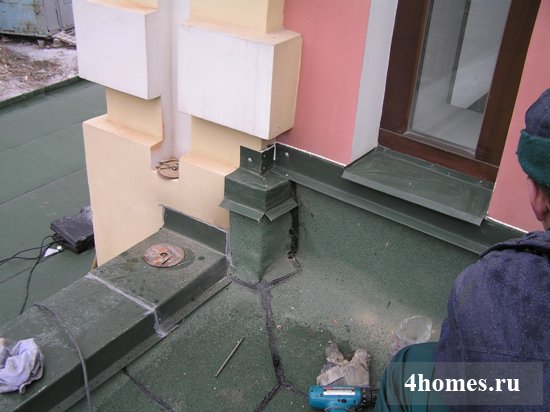
All joints of the protective elements are sealed with a special one-component polyisobutylene sealant. Such a sealant is packed in a tube, which looks like a syringe, and is squeezed out using an assembly gun, which allows you to fill the seams as tightly as possible.

A soft roof will last long enough, at least 10 years, and if you use a "premium" class fused roofing material, then up to 15 years. When installing a soft roof, it is important to take into account all the conditions of its operation (the purpose of the building, the slope of the roof, the amount of average annual precipitation) and to correctly observe the technology at all stages of the coating device.
Materials and tools. Styling. Procedure. Storage conditions.
For the device of a protective waterproofing layer flat roof or concrete bases (for example, a foundation, a basement), a bitumen weldable roll material is used - glass insulation or the laying of which allows you to form the necessary waterproofing layer on the roof or concrete base, protecting against the negative destructive effects of moisture.
Currently, manufacturers of glass-insulated produce several grades of glass-insulated, differing in their purpose (field of application), properties, and characteristics.
To designate (mark) various brands of glass insulation, abbreviations are used, the letters of which have the following meaning:
- X or T - canvas ( glass canvas) or fabric ( fiberglass) - type of base for glass-insulating, hydro-insulating;
- K, M, P - coarse-grained dressing, fine-grained dressing, polymer film - type of protective coating (layer).
A quality fusion bitumen flat roof consists of several layers, traditionally called top and bottom roof carpets (layers).
For the device of the lower roofing layer of a soft flat roof, as well as waterproofing reinforced concrete structures used rolled bitumen deposited material - glass insulation (other used by different manufacturers names: gidroizol, gidrostekloizol, filisol, linokrom, bikrost, uniflex, etc.) using fiberglass or canvas as a base, brands, etc.
For the device of the upper roofing layer (carpet), glass insulation is used with coarse-grained protective dressing on the front side of the canvas, brands or.
The basic steps in this quick start guide for roll-on bonding are equally applicable to waterproofing using , or .
Surface preparation.
To ensure good adhesion of the glass-insulated layer to the concrete base, it must first be cleaned of dirt, dust, leaves, debris, foreign objects, ice, snow (if the roof is laid in the winter season) and treated with a special compound (soil) -. Along with the concrete base, it is also necessary to clean the funnels of the internal drain from debris, check the drains for the presence of foreign objects in them that impede the drainage of water.
For cleaning various debris from the surface of the waterproofing base, you can use or .
Before starting surface treatment bituminous primer, you should check the status concrete base buildings, structures. The seams of reinforced concrete bearing slabs and cracks that have arisen, destruction caused by mechanical stress must be pre-sealed with a cement-sand mortar.
On preparatory stage, it is also necessary to form the necessary slope-forming layer, since on the roof of any building, structures are placed vertically located in relation to the bearing plates various technological structures (for example, the structures of ventilation risers, air intakes).
Therefore, in the places where the insulating layers adjoin them, as well as to the walls, ledges, parapets, it is necessary to erect inclined fillets (sides) covering the joint between the concrete base of the roof and walls, parapets and other objects at an angle of 45 degrees. To form a slope, you can use foam concrete, cement-sand compositions, expanded clay.
The funnels of the internal drain should be located over the entire roof area, taking into account building standards and norms, slightly below the main roofing layer with their obligatory fastening to the capital structures of the building, structure.
When laying glass insulation on old roof, it is necessary to remove all torn parts that are not adjacent to the surface of the base.
Glass insulation laying.
After all the necessary preparatory work, you can start laying glass insulation.
At the first stage, it is necessary to prime the entire surface on which the roofing carpet is supposed to be laid with a special primer. For the treatment of cement-sand and concrete surfaces, it is recommended to use a bituminous primer. The primer is applied using rollers, brushes, brushes.

The bitumen primer provides for the "adhesion" of the glass-insulated or hydro-insulated sheet to the concrete base, and is also used to increase the adhesion ("sticking") of the lower layer of the roofing carpet to the upper one. Alternatively, cold application (MBU) can be used to prime the concrete surface before laying the glass insulating sheet.
Average consumption bituminous primer ready per 1 m 2 with a single-layer coating 250-350 ml / 1 m 2.
Consumption universal bituminous mastic (MBU) at waterproofing works: 2-3 kg / m 2, when gluing building materials - 0.8-1 kg / m 2
Preparation of the surface of the base of a flat roof is an important stage in the waterproofing of a soft roof. In the preparation and priming of the base surface for laying the deposited materials, we examined the basic steps of priming the surface.
After the surface is primed, you should start laying glass insulation. For safety reasons, the simultaneous melting of glass insulation and the application of a bitumen primer or.
Laying of glass insulation begins from the lower sections of the roof (funnels, cornices) with a side overlap of adjacent canvases of at least 80-100 mm.
In areas where horizontal and vertical surfaces converge, it is recommended to lay additional layer roofing carpet.

The glass insulation sheet is laid on the prepared surface by heating, melting the lower adhesive layer (covered with a protective film) using a gas burner, gradually rolling the roll towards itself. Heating is carried out by measured movements of the gas burner, ensuring uniform heating of the lower layer of the web.
Along the edges of the heated glass-insulating sheet, 1-2 centimeters of molten bitumen should protrude, which will ensure high-quality gluing of the seams between adjacent sheets.
Each roll of glass insulating material contains an unprocessed edge for overlapping.
Gas consumption when fusing waterproofing material about 0.8 l /
m 2.After laying, it is necessary to make sure with a spatula that the seams are glued together.
 Schematically (the image is indicative and presented for reference) a waterproofing carpet of a flat roof made of bitumen deposited materials looks as follows:
Schematically (the image is indicative and presented for reference) a waterproofing carpet of a flat roof made of bitumen deposited materials looks as follows:
1. Concrete primed with bitumen primer or bitumen mastic;
2. The bottom layer of the roofing carpet (TPP or HPP);
3. Top layer of roofing carpet (TKP or HKP).
If there is a slight slope of the roof, the joints should be made in the direction of the slope of the roof that allows water to drain off.
Laying glass insulation is allowed at a temperature not lower than -3 o C.
When conducting roofing works in conditions of negative temperatures, materials for the roof must be kept in a warehouse at a temperature of at least 15-20 degrees for at least a day.
Storage conditions. Glass insulation should be stored in rolls, in an upright position, away from sources of heat and fire.
When performing work, it is necessary to use protective equipment and observe safety precautions.
Video instruction for laying rolled bituminous materials from the TechnoNIKOL company.
Read also:
- Spring inspection of a flat roof - content, basic elements, assessment of the condition of the roof,.
- A quick guide to repairing a soft roof made of bitumen roll materials,.
- A brief guide to the preparation of a concrete base of a flat roof for laying bitumen deposited roll materials,. Building bitumen,,,.
Construction of a house, bath, garage or capital renovation works starts with budgeting. It includes the planned amount to pay for the work of the masters and the purchase necessary materials... Therefore, it is important to know exactly how much and what will be spent. For example, the consumption of waterproofing directly depends on the type of surface treatment products used. In order not to be mistaken in the calculations, one must clearly understand what is included in the required scope of work.
Waterproofing is a necessary set of measures, the purpose of which is to ensure the protection of building materials in erected houses from the harmful effects of moisture. Correctly carried out work allows you to postpone the day of the beginning of the planned repair, as it prevents the penetration of water into the structure of the materials used.
By type, waterproofing is divided into:
- Coating room. It is carried out using bitumen-containing materials and is suitable for processing large areas.
- Penetrating. Due to crystallization processes, it protects the surface from water.
- Reserving. A thick waterproof layer protects materials from high humidity.
Among the most common waterproofing materials, it is worth noting:
- Bitumen and its derivatives;
- Ceresite;
- Penetron;
- Lakhta.
Knowing the consumption of materials, their main properties and manufacturer's recommendations, it is very easy to select perfect solution for high-quality waterproofing.
If you make a mistake with the calculations for waterproofing, excess material may remain
Waterproofing consumption: learning to plan a budget based on materials
When carrying out any construction and repair work, always look at the consumption of waterproofing per 1m2. This makes it much easier to calculate the required volumes.
Important! In addition, knowing the flow rate of waterproofing allows you to make the right solution and get the highest quality result in work. To control the processes, it is recommended to refer to GOST, which regulates such indicators.
So, bituminous waterproofing - the consumption will be from 2 to 3 kg per one square meter the processed surface. it coating waterproofing, therefore, the coating is always multi-layered. The final thickness of the applied materials can be up to two centimeters. Bituminous waterproofing is widely used to treat exterior wall surfaces to provide maximum protection against groundwater.
Ceresite is the second most popular type of waterproofing materials. This generalized name characterizes the products of Henkel Bautechnik, and includes several types of mixtures. Most often used:
- Ceresit mastic CL51;
- Ceresite mass CR65.
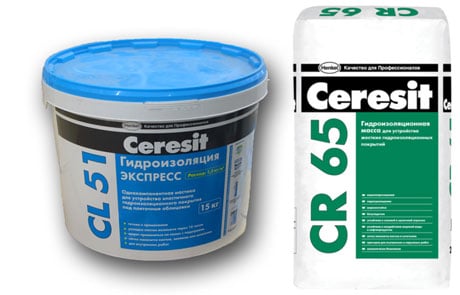
Ceresite mass is very popular for waterproofing works.
Ceresit mastic is used for local waterproofing when installing shower cabins, bathtubs and other plumbing products. But for the mass - Ceresit waterproofing - it is very important to know the consumption, since it is widely used in the construction building structures, swimming pools. At the same time, special requirements for the working surface have of this material not.
Waterproofing Ceresit CR 65 - consumption is up to 8.5 kg per square meter. Such a volume of mass is justified, since it is applied in two working passes, and then it is also recommended to apply a finishing layer.
Waterproofing Penetron - the consumption is planned for a two-layer application and is equal to 0.8 kg per square meter.
Important! With an uneven surface, as well as with cracks, the amount of material used can increase up to 1.1 kg per square meter.
The use of Penetron as an insulating material allows you to create an absolutely waterproof concrete surface.
Waterproofing Lakhta - consumption is 1.7 kg per square meter. Most often, the tool is in demand when processing brick, concrete and reinforced concrete surfaces. Lakhta provides protection due to crystallization processes, which increases the durability of the layer being created.
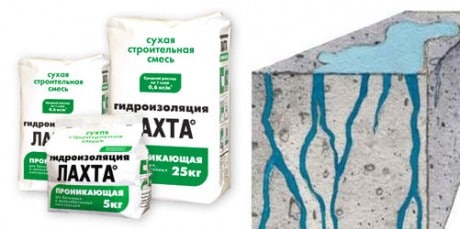
Lakhta waterproofing action
What else is important to know when calculating the cost of waterproofing
The most serious area when building a house is the foundation. And not even because the whole structure rests on it, but because in the future there will be no access to it. Therefore, it is very important not to save money at the first stage of construction. Foundation waterproofing implies a significant consumption and usually with the use of liquid rubber... This material belongs to expensive means and its consumption is from 4 to 6 kg / m2, depending on the type.
The second critical area in the house is the roof. It is important to take into account the consumption of propane for waterproofing when using roll materials.
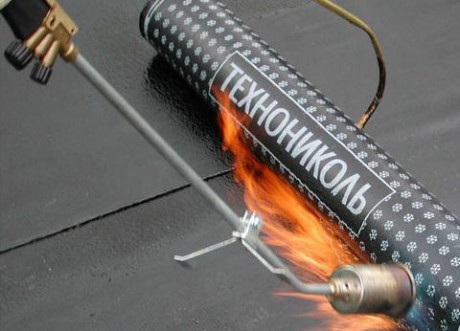
Propane is required for laying roofing roll material
How not to make a mistake in the calculations
The main danger when planning a budget is miscalculation. If you put too little volume in the estimate, then there simply will not be enough materials. If you overdo it, you will end up with a surplus.
Only professional builders can solve all the issues correctly and make an optimal estimate. They know which waterproofing material and how much should be applied on the surface different types... Professionals will also advise on the costs of related materials and aids. Of course, such services are paid, but it is worth noting that errors in the estimate can be much more expensive than the help of a specialist.



